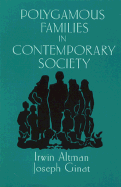Book contents
- Frontmatter
- Contents
- Foreword
- Preface and acknowledgments
- 1 Introduction
- Historical background
- Early stages of relationships
- Home environments of plural families
- Managing everyday life
- Social-emotional and family relationships
- 16 Social-emotional relationships of husbands and wives
- 17 Relationships between wives
- 18 Family structure
- 19 Parents and children
- 20 Summing up
- Appendix A Methodology and procedure
- Appendix B Demographics of Mormon polygyny
- Notes
- References
- Index
17 - Relationships between wives
Published online by Cambridge University Press: 05 May 2010
- Frontmatter
- Contents
- Foreword
- Preface and acknowledgments
- 1 Introduction
- Historical background
- Early stages of relationships
- Home environments of plural families
- Managing everyday life
- Social-emotional and family relationships
- 16 Social-emotional relationships of husbands and wives
- 17 Relationships between wives
- 18 Family structure
- 19 Parents and children
- 20 Summing up
- Appendix A Methodology and procedure
- Appendix B Demographics of Mormon polygyny
- Notes
- References
- Index
Summary
Plural family life is greatly affected by relationships between wives that are more or less independent of the husband. These relationships revolved around their general feelings about living with one another in plural families, their mutual responsibilities for managing homes, how they get along rearing their children, and their interpersonal compatibility.
Home management
Cooking, cleaning, meal preparation, and other aspects of managing a home are important social and religious responsibilities of contemporary plural wives. Needless to say, women in American and Western cultures have also have had the same responsibilities for generations – and still do today, notwithstanding the recent trends that have blurred rigid gender roles.
A fundamentalist Mormon woman's role in the home has both theological and cultural roots. According to Mormon doctrine, a man is the religious and social leader of the family, teaches his wives and children theological values, and may govern his family in their own heavenly “universe” in the afterlife. Women are expected to maintain “stewardship” of the home; raise and teach their children proper social, moral, and religious doctrine; and strive to build a healthy relationship with their husband. The home is also a place where a wife can display her own personality, creativity, and independence from other wives. Thus managing the home is a strong gender-linked responsibility of women in plural families. In this sense, caring for the home has strong dyadic meanings since it bears directly on husband–wife and wife–children relationships.
- Type
- Chapter
- Information
- Polygamous Families in Contemporary Society , pp. 366 - 386Publisher: Cambridge University PressPrint publication year: 1996

